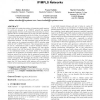Free Online Productivity Tools
i2Speak
i2Symbol
i2OCR
iTex2Img
iWeb2Print
iWeb2Shot
i2Type
iPdf2Split
iPdf2Merge
i2Bopomofo
i2Arabic
i2Style
i2Image
i2PDF
iLatex2Rtf
Sci2ools
IMC
2007
ACM
2007
ACM
Quality-of-service class specific traffic matrices in ip/mpls networks
In this paper we consider the problem of determining traffic matrices for end-to-end demands in an IP/MPLS network that supports multiple quality of service (QoS) classes. More precisely, we want to determine the set of traffic matrices Ti for each QoS class i separately. Ti contains average bandwidth levels for QoS class i for every pair of routers within the network. We propose a new method for obtaining QoS class specific traffic matrices that combines estimation and measurement methods: We take advantage of the fact that the total traffic matrix can be measured precisely in MPLS networks using either the LDP or RSVP-TE protocol. These measurements can then be used in a mathematical model to improve estimation methods – known as network tomography – that estimate QoS class specific traffic matrices from QoS class specific link utilizations. In addition to the mathematical model, we present results of the proposed method from its application in Deutsche Telekom’s global IP/MPL...
| Added | 26 Oct 2010 |
| Updated | 26 Oct 2010 |
| Type | Conference |
| Year | 2007 |
| Where | IMC |
| Authors | Stefan Schnitter, Franz Hartleb, Martin Horneffer |
Comments (0)

